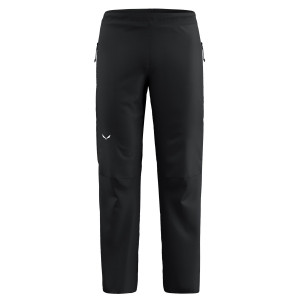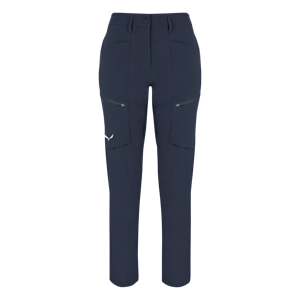Women's Hiking / Trekking Pants
(11 Products)When it comes to taking on mountains it all comes down to heart eventually. Can you keep going when your body and your mind scream stop? Still, it never hurts to have a durable exterior as well. That’s where the Salewa range of hiking pants for women comes in. Each item in the selection of trekking pants for women is designed to be both lightweight, breathable and flexible. Our women's hiking trousers are also designed to stand the test of time by keeping their shape even after multiple washes. Gusseted crotches and ergonomic waistbands also mean you can take on a longer trek without chafing or discomfort afterwards. Just like our collection of hiking jackets, weather-resistance is a key feature of our trekking trousers women's collection. Expect to find a variety of features such as water-repellent fabric and advanced UV protection. Prepare yourself for a hiking adventure that lasts as long as your will and choose items from our women's hiking bottoms that will help you reach your summit this climbing season.
What pants do women hike in?
Women can wear any type of hiking pants they choose, from conventional hiking pants to zip-off pants etc. Functional tights are also becoming more popular, offering the advantage of being very packable on longer multi-day hikes, and being less likely to get snagged up on rocks etc. due to their close fit.
How do I choose the best hiking pants for women?
The pants you wear for hiking need to be sturdy yet lightweight and offer full freedom of movement for taking big strides or steps. Some hiking pants also come with wind and water protection. So consider the climate you’ll be hiking in and the terrain you’ll encounter before choosing hiking pants. Also consider what kind of features you’d like, such as pockets, zip-off legs (into shorts), adjustable cuffs, sun protection or even insect repellence. Read our expert article for detailed information on how to choose the best hiking pants.
What’s the best material for hiking pants?
Hiking pants made from pure cotton or hemp will take longer to dry and therefore could be cold and heavy in wet weather. Functional synthetic fibres, on the other hand, will dry quickly and provide good breathability and moisture wicking performance. Salewa’s Durastretch fabric has the added benefit of stretch performance.
How should hiking pants fit women?
The kind of fit you choose for your hiking pants will depend on your personal preference but also on things like the need for layering in colder weather. A wider fit will allow you to add thermal underwear underneath. But closer fitting hiking pants also have the benefit of trapping air closer to the body for efficient insulation, and also less chances of snagging on rocks and branches. Comfort around the waist is important, especially when carrying a backpack, so look for flatlock seams perhaps, or soft inserts at the back.
Should hiking pants be tight or loose?
Hiking pants that are too loose have the potential to rub, chafe or get snagged up on bushes and rocks. But hiking pants that are too tight can be restrictive. So opting for a sensible balance and trying before buying is best. Whether you go for tighter or looser fitting hiking pants will largely depend on your layering needs too. A wider cut will allow extra layers like thermal underwear to be worn. More close-fitting stretch hiking pants are better for more athletic hiking.
Can I wear yoga pants to hike?
Yoga pants and leggings are extremely comfortable and flexible, as well as highly packable. But try to opt for ones that are designed for hiking, as these will be made from more durable material and also have reinforced panels on the knees and seat for better abrasion resistance. Thorny shrubs or sharp rocks can be very damaging to thinner fabrics.
Are softshell pants good for hiking?
Softshell material is a great option for hiking pants, particularly in colder conditions. With insulating material on the reverse side and weather protection (DWR finish) on the outside, it’s hard to beat for winter hiking. Softshells are often warmer, so in summer or hotter climates, they might be less suitable.

 Free shipping on orders over $200 - No minimum for registered users
Free shipping on orders over $200 - No minimum for registered users









